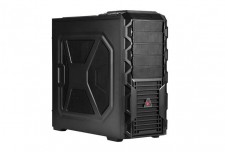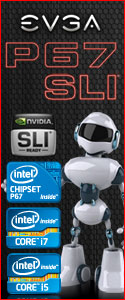External Looks
On first sight it is kind of hard to gauge what the front panel looks like. Not that there is anything wrong with its aesthetics, however if one tries really hard then we could almost liken it to something akin to a futuristic look.
 |
 |
 |
 |
The chassis sports five 5.25″ drive bays at first glance (more on this later) and a 120mm front intake fan of which uses the usual Blue-Led colouration. So without further aplomb let us slowly work around the outside of the case and explain some of its features.
 |
 |
 |
 |
The I/O panel has a rather large power button in the centre, that has a chrome finish of which lights up a typical Blue colour. Here at OCT we are getting a little bored of the constant Blue lights that come standard in cases. This shade of LED used to be the fashion some three years ago, however like everything else tastes have moved on. A good suggestion would have been to utilise a dual LED where one could have the a colour to indicate standby or power off mode and another to represent the powered on phase. To the left of this one has the HDD activity indicator which glows a deep red and the front FAN led indicator which glows a blue. It is also worth noting that the fan and the two indicators glow a similar shade. Above these, we have the reset button and the ability to turn off the clichéd Blue light of the front intake fan. Next to these we have the functions of fan on/off for the intake and exhaust fans. At the top of the panel we have two USB and 3.0 and one USB 2.0 sockets and the usual Microphone and speaker connections. Overall the I/O section is spaced out well, easy to reach for all functions and intuitive. The only thing that bugs us is the obsession with catering to the colour BLUE for the LED’ functions otherwise we see no real issues with the panel.
Whilst we are on the top panel a fan grill lies behind the I/o panel of which can hold either two 120mm fans or two of the 140mm variety.
 |
 |
Next we move onto the front 5.25 bay area.
 |
 |
 |
 |
The front intake sports a bright Blue LED fan which is of the 120mm variety and is fairly quiet to boot. What we have noticed is that all the bay clips and the whole front panel in general sport dust filters which is great news for the avid consumer whom has no wish to blow dust out of the machine every month or so.
 |
To be honest everything here is pretty much standard with nothing nothing unusual here or to be fair wrong either. The front of the chassis whilst not being inspiring it doesn’t have any faults either.
Moving around to the side panel we some rather interesting designs. Rather than it being the usual grill for a side panels the design is only aesthetic in appearance.
 |
 |
 |
 |
 |
Moving on to the rear panel we have eight PCI-E slots a 120mm fan hole and four rubber grommets for water cooling tubing. The latter we find an issue with as we are of the opinion that ‘drilling’ holes in the back of a case does NOT make the chassis water cooling ready and in our opinion Spire need to pay close attention to this. If a user cannot fit both the fans and a thin 30mm depth 240mm radiator inside without obstructing the motherboard then it is simply not watercooling capable.
With the above taken into consideration let us move on to the internal workings of the SPIRE X2 6019 MOD chassis.

 Posted in
Posted in 
 Store
Store


